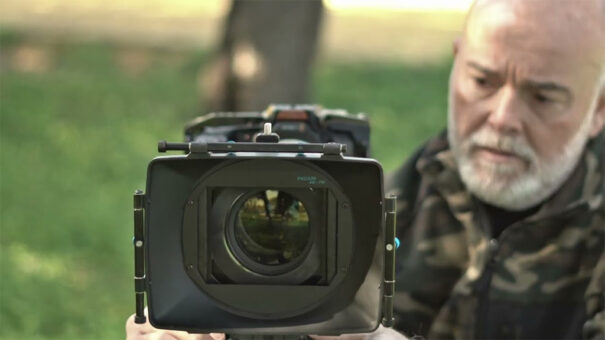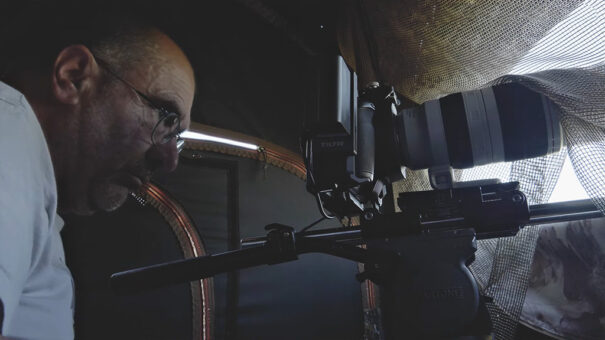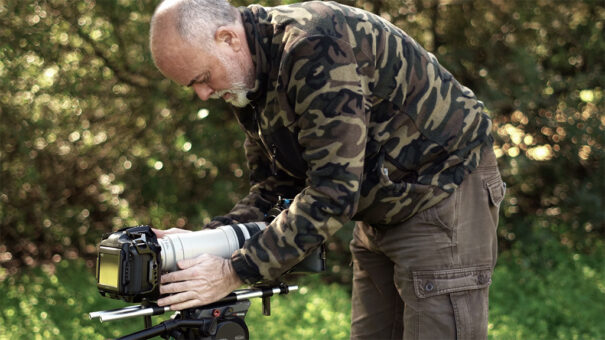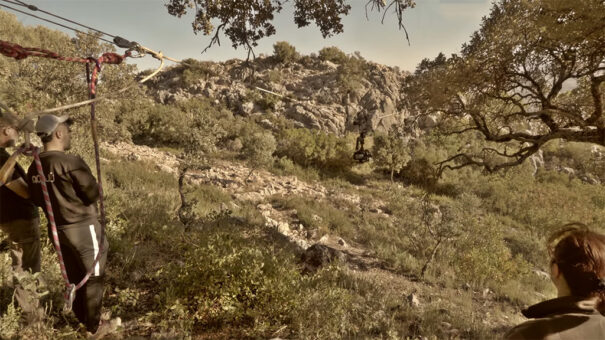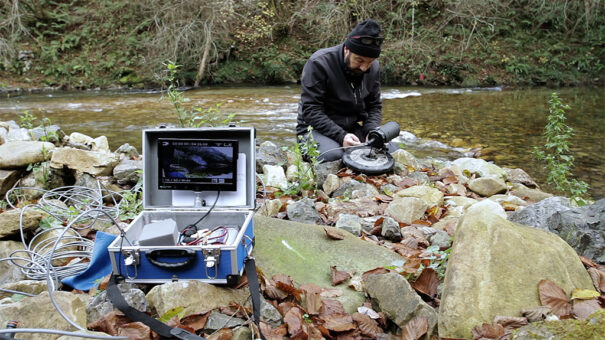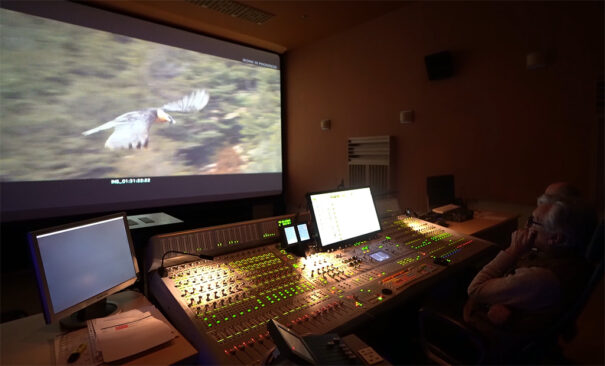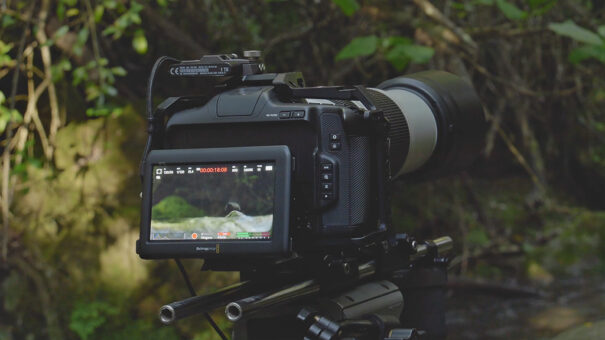Rodando cine de naturaleza: la tecnología de ‘Iberia, naturaleza infinita’
Arturo Menor, director, guionista y responsable de la fotografía de la candidata al Goya a Mejor Película Documental ‘Iberia, naturaleza infinita’, desgrana los ejes tecnológicos de su última obra.
53 semanas ha dedicado el equipo de Acajú Comunicación Ambiental a dar forma a su última película, Iberia, naturaleza infinita, la cual lleva al siguiente nivel el extenso catálogo de piezas de naturaleza de Arturo Menor y sus dos largometrajes previos: WildMed, el último bosque mediterráneo (2014) y Barbacana, la huella del lobo (2018). Menor traslada en 75 minutos repletos de imágenes sobrecogedoras la historia de un águila real que, expulsada de su hábitat, emprende una aventura de supervivencia por toda la península ibérica.
La cinta nace con el objetivo de tratar un problema relacionado con la preservación de la naturaleza, escogido por el propio Menor, también naturalista y biólogo: la electrocución de grandes aves en tendidos eléctricos, la principal causa de mortalidad no natural de aves en España. Para ello, el equipo de Iberia, naturaleza infinita, compuesto de habituales en producciones de ficción y colaboradores como naturalistas, parte de un guion que se tornará en imágenes recogiendo la espontaneidad de especies como águilas salvajes, visones u osos.
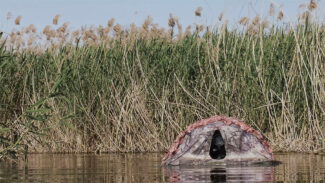 Esta mezcla de intenciones y realidades hace que Menor decida huir de la etiqueta de documental, para enmarcar a su último trabajo en la categoría de “película de naturaleza”: “El águila, protagonista de nuestra película, en realidad son 14 águilas reales distintas, de las cuales diez son salvajes y cuatro son de cetrería, adiestradas”.
Esta mezcla de intenciones y realidades hace que Menor decida huir de la etiqueta de documental, para enmarcar a su último trabajo en la categoría de “película de naturaleza”: “El águila, protagonista de nuestra película, en realidad son 14 águilas reales distintas, de las cuales diez son salvajes y cuatro son de cetrería, adiestradas”.
La ambición, más allá de residir en la decisión de conectar tanto con el gran público, como con aquellos amantes de la naturaleza, se ejemplifica en un equipo técnico con un notable currículum: José M. G. Moyano (Goya por La Isla Mínima, La Peste, Modelo 77…) y Manuel Terceño al montaje (Un país para escucharlo, Pioneras, El Estado contra Pablo Ibar); Carlos de Hita (Maixabel, Dehesa: El boque del lince ibérico, Guadalquivir) y Jorge Marín al sonido (Goya por 3 días, Honor, Sevillanas de Brooklyn), o Pepe Domínguez del Olmo, doble ganador del Goya por Modelo 77 y La Isla Mínima, quien se encargó de recrear en un estudio un nido de águila real.
Menor, desde su atalaya privilegiada como director, guionista, premontador y también director de fotografía, detalla cómo se ha desarrollado la producción y postproducción de Iberia, naturaleza infinita sin escatimar en detalles. Captación, sonido, edición o color son abordadas en esta conversación, trasladando la complejidad, pero también la magia, del cine de naturaleza.
Imprevisibilidad controlada
60 localizaciones de 19 provincias de toda España han permitido a Arturo Menor y a su equipo trasladar su visión de Iberia. Largas jornadas de rodaje, en las que se aprovechaban al máximo los amaneceres y los atardeceres (momentos de activación de su imprevisible elenco actoral), se distribuyeron a lo largo de más de un año, siempre huyendo del calor y del frío más extremo.
“Gracias a los naturalistas, fotógrafos y biólogos que contratamos, sabemos los sitios donde va a ocurrir lo que queremos filmar, como puede ser el celo de los visones o las avutardas”.
La planificación de Iberia, naturaleza infinita no se alejó del esquema inicial, algo que puede pasar por los lectores al imaginar las largas horas de espera (e incluso jornadas) referenciadas por opulentos narradores en los documentales más tradicionales. Para conseguirlo, Menor y su equipo se apoyaron en tres figuras claves: naturalistas, fotógrafos y biólogos: “Gracias a estos perfiles, sabemos los sitios donde va a ocurrir lo que queremos filmar, como puede ser el celo de los visones o las avutardas”.
El equipo de Iberia está en contacto constante con estos perfiles, hasta que llega la deseada llamada en torno a la fecha estipulada en el calendario provisional: “Llega un momento en el que nos dicen: mira, el martes de la semana que viene va a ser un día óptimo para hacer esto. Y normalmente, cuando vamos a los sitios, pasa lo que teníamos previsto que ocurriera. Si no, sería imposible hacer la película, porque son tantas cosas y tan diferentes… ¡En esta película salen más de ochenta especies distintas!”
Captación: máxima versatilidad
Salvo en contadas ocasiones, los rodajes del equipo de captación de Iberia, naturaleza infinita, con Menor junto con José Antonio Vallejo como camarógrafos, han implicado largos desplazamientos que, en ocasiones, suponían varias horas de “caminata”: “Lógicamente, muchas de las secuencias son en localizaciones remotas: donde están las águilas o los urogallos. Teníamos que ir andando hasta el escondrijo cargando cámaras, ópticas, baterías, trípodes e incluso sacos de dormir, esterilla, agua o comida si teníamos que hacer noche”.
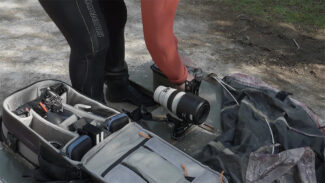 La dificultad logística del rodaje llevó a Menor decantarse por un equipo lo más ligero posible, motivo por el que, alejándose de opciones cinematográficas más habituales en rodajes para la gran pantalla, eligió la Pocket Cinema Camera 6K Pro of Blackmagic Design: “Es una cámara que graba en RAW y 6K, y que nos da una calidad magnífica para cine”. Con respecto a las ópticas, el director de fotografía se decantó por ópticas ligeras de Canon. Concretamente, un objetivo 24-70mm y un 100-400mm: “Los animales no están tan lejos como solemos pensar. Contratamos a los naturalistas para que nos ayuden a acercarnos lo máximo posible a la acción. Las ópticas, lógicamente, están muy limitadas por la propia física, y sabemos que si nos encontráramos a más distancia podríamos enfrentarnos a aberraciones o a la propia reverberación del aire”.
La dificultad logística del rodaje llevó a Menor decantarse por un equipo lo más ligero posible, motivo por el que, alejándose de opciones cinematográficas más habituales en rodajes para la gran pantalla, eligió la Pocket Cinema Camera 6K Pro of Blackmagic Design: “Es una cámara que graba en RAW y 6K, y que nos da una calidad magnífica para cine”. Con respecto a las ópticas, el director de fotografía se decantó por ópticas ligeras de Canon. Concretamente, un objetivo 24-70mm y un 100-400mm: “Los animales no están tan lejos como solemos pensar. Contratamos a los naturalistas para que nos ayuden a acercarnos lo máximo posible a la acción. Las ópticas, lógicamente, están muy limitadas por la propia física, y sabemos que si nos encontráramos a más distancia podríamos enfrentarnos a aberraciones o a la propia reverberación del aire”.
Este deseo de acercarse a los animales ha llevado a Menor y a Vallejo a confiar el foco y la operación de la cámara a su propia destreza, prescindiendo de extensores o herramientas intermedias: “Son horas y horas esperando a que venga el animal. Las únicas tomas que hemos hecho con una extensión de cable son las subacuáticas, con los salmones. Colocamos la cámara bajo el agua y con un monitor externo vigilábamos lo que estaba ocurriendo bajo el agua”.
Buscando tomas únicas con drones, FPV, cablecam…
Menor reconoce encontrar su inspiración para soluciones técnicas en otros documentales de naturaleza, los cuales trata de ver en sus fases de preproducción para inspirarse de cara a sus próximos trabajos. El águila real, en esta ocasión, era el pretexto ideal para poner a prueba diversas soluciones tecnológicas de captación aérea no tan frecuentes en su producción previa.
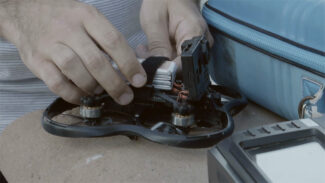 Un viejo conocido es el dron, concretamente el Mavic 3 of DJI, el cual fue usado para capturar imágenes espectaculares de algunos de los paisajes más destacados de la península ibérica. En esta producción, tuvo un hermano pequeño que permitió aportar tomas inéditas en la producción de Acajú: “Usamos un dron mosquito construido y operado por Iván Merino, campeón de la Liga Ibérica de drones. Es la mínima expresión del dron: es muy pequeño y llevaba una cámara GoPro Hero10 totalmente desmontada, con lo justo para el objetivo, el procesador para grabar las imágenes y la batería”. El set de soluciones aéreas lo completó una pequeña cámara acoplada a algunas de las águilas reales que permitió generar planos en primera persona de gran espectacularidad.
Un viejo conocido es el dron, concretamente el Mavic 3 of DJI, el cual fue usado para capturar imágenes espectaculares de algunos de los paisajes más destacados de la península ibérica. En esta producción, tuvo un hermano pequeño que permitió aportar tomas inéditas en la producción de Acajú: “Usamos un dron mosquito construido y operado por Iván Merino, campeón de la Liga Ibérica de drones. Es la mínima expresión del dron: es muy pequeño y llevaba una cámara GoPro Hero10 totalmente desmontada, con lo justo para el objetivo, el procesador para grabar las imágenes y la batería”. El set de soluciones aéreas lo completó una pequeña cámara acoplada a algunas de las águilas reales que permitió generar planos en primera persona de gran espectacularidad.
Otra solución innovadora fue el uso de un sistema de cablecam de grandes dimensiones que se montó en Algámitas, un pueblo de la Sierra Sur sevillana, y que se utilizó para capturar el vuelo de varias águilas entre dos cetreros: “Nos pusimos en contacto con Noxon, una empresa de Navarra que tienen un sistema de cablecam con muy buenas prestaciones, y que han sido encantadores y se han volcado en el proyecto. Con este sistema, trazando unos vuelos de águila muy concretos, pudimos rodar planos muy cercanos a las aves”. El equipo de Acajú completó el sistema de Noxon con un estabilizador de la marca asiática Zhiyun.
Rodando en territorios inhóspitos
Iberia, naturaleza infinita is a producción rodada en 6K, si bien posteriormente ha sido transcodificada a 2K para su distribución en cine y su futura llegada a plataformas digitales: “Nuestro distribuidor nos comenta que ni se demanda ni se paga la película en 4K, así que hemos decidido apostar por este formato”.
“Nuestro distribuidor nos comenta que ni se demanda ni se paga la película en 4K, así que hemos decidido apostar por el 2K”.
Los 6K rodados en formatos RAW implican unas altas velocidades de transferencia, así como importantes requisitos de almacenamiento. Prescindiendo de equipos de mayor tamaño, frecuentes en grandes producciones en entornos de rodaje controlados, Menor se decantó por tres discos duros SSD of Samsung of 1 TB cada uno.
Otra problemática era la cuestión de las baterías, imprescindibles para no perderse la actuación estelar de los protagonistas de la película: “Llevamos ocho baterías numeradas y ordenadas en la mochila. Si se te acaba la batería y tienes delante un lince, por ejemplo, tienes que cambiar rápidamente la batería y no estar pendiente de si vuelves a poner una que esté descargada”.
Cuando los actores sorprenden para bien… y para mal
El rodaje de una película de naturaleza arroja anécdotas y situaciones inesperadas que se traducen en oportunidades cinematográficas, experiencias desafortunadas o momentos sorprendentes para todo el equipo de producción. Menor, tras pasar semanas y semanas tras la cámara tratando de hacer realidad su guion, guarda en su memoria dos momentos del rodaje de Iberia, naturaleza infinita.
El primero está protagonizado por el alzacola, una coqueta ave natural del norte de África ya habitual en el sur de España: “Rodamos el Alzacola en Montilla, un pueblo de Córdoba, y curiosamente, para nuestra sorpresa, es un ave muy dócil que nos dejó acercarnos mucho y hacer lo que queríamos durante el rodaje. Hemos tenido la posibilidad de hacer contraluces, o de cambiar de posición para provocar que el ave se posara en una cepa o en una rama concreta. No es nada frecuente, pero nos ha dado muchas posibilidades”.
La segunda anécdota no es tan afortunada: “Normalmente, las águilas reales se recogen en enero como tarde, puesto que empieza la época del celo. Como todo el mundo, en ese momento se vuelven más ariscas y agresivas. Como estábamos rodando la película y teníamos unos objetivos, tuvimos que estirar un poco más la época de recogida del águila”, traslada el director de fotografía, aportando contexto a la anécdota: “Estábamos rodando, y yo estaba tan a gusto viendo cómo el águila venía hacia mí haciendo un picado magnífico. Estaba a lo mío, intentando que todo estuviese cuadrado, en foco, y en ese momento el cetrero vino corriendo hacia mí porque él era consciente de lo que estaba pasando: el águila venía a por mí con mala uva. Afortunadamente, el cetrero la disuadió de pegarme un golpetazo, si bien yo ya estaba preparado para protegerme tras el trípode y la cámara. ¡Gajes del oficio!”
Creando paisajes sonoros en postproducción
Como es habitual en muchas piezas de cine de naturaleza, el equipo de Iberia, naturaleza infinita prácticamente prescindió de la captación de sonido en las tomas, dadas las dificultades logísticas que implicaba. En el premontaje de la película, Menor introdujo sonido de referencia captado directamente por las cámaras en base al cual Carlos de Hita construyó el diseño sonoro de la película: “Como él dice, prácticamente lo que le entregamos es una película muda”.
En base a esas referencias sonoras ambientales y los elementos visuales de la cinta, De Hita se encarga de construir paisajes sonoros que ayudan al espectador a aproximarse a los escenarios de rodaje: “Normalmente pone una base de viento, teniendo en cuenta que este suena distinto en un campo abierto que en un bosque de hayas. Luego añade recursos que dan profundidad al plano, como que se escuche de fondo a un cuervo, y añade elementos en primer plano con su respectivo paneo: por ejemplo, en el cine oyes al ave volando por tu derecha y luego entra por ahí al plano”.
Los elementos sonoros de Iberia, naturaleza infinita se completan con un importante trabajo de foley, con el que De Hita recreó elementos como la pisada de los animales, el sonido de un águila posándose en un tronco o los propios aleteos de las aves, creados utilizando guantes o material de cuero.
Montaje, VFX y color
Menor acometió el premontaje de Iberia, naturaleza infinita apoyándose en el software Final Cut Pro X. La primera versión de la cinta duraba dos horas, las cuales fueron reducidas, condensadas y mejoradas por el trabajo de José M. G. Moyano: “Cada vez que iba a verlo disfrutaba un montón con cómo iba evolucionado todo y cómo iba dando su toque personal. Siempre me gusta decir que los montadores son especialistas en el montaje audiovisual y corrigen las faltas de ortografía que puedo cometer yo”.
“Hay un episodio en el que muere una de las águilas electrocutada. Rodamos al águila en un estudio con croma, la integramos en el paisaje y dibujamos digitalmente un arco voltaico, que es el elemento que hace que se electrocute el águila y lo que desencadena la electrocución”.
Iberia también cuenta con hasta 60 planos fueron llevados a cabo bajo la coordinación de Juan Ventura Pecellín of Antípodas Film Lab, estudio definido por Menor como “uno de los más modernos que puede haber ahora en Andalucía para estos trabajos”. Algunos de los trabajos llevados a cabo fue la integración del nido del águila real en paisajes naturales, la eliminación de elementos que puedan distorsionar (como “una torre de telefonía”), la integración de un águila volando en un paisaje de los pirineos que fue rodada frente a una pantalla verde o la generación de uno de los momentos más chocantes del film: “Hay un episodio en el que muere una de las águilas electrocutada. Rodamos al águila en un estudio con croma, la integramos en el paisaje y dibujamos digitalmente un arco voltaico, que es el elemento que hace que se electrocute el águila y lo que desencadena la electrocución”.
Para la corrección de color, Menor volvió a confiar en Juan Ventura, quien llevó a cabo esta tarea con el software DaVinci Resolve of Blackmagic: “En ficción, a veces puedes dar un color peculiar o un punto personal para que la película destaque y te llame la atención como espectador. En el caso de Iberia, naturaleza infinita, pedí que respetase al máximo los colores naturales, porque al final es de lo que se trata: de que la naturaleza se vea realista y no esté distorsionada con elementos raros que la perturben”.
El camino hacia el próximo documental
A punto de completar el ciclo de Iberia, naturaleza infinita, con la prometedora nominación a los Premios Goya en el horizonte, Arturo Menor ya piensa en su siguiente producción: “Para la próxima película, tengo la tarea de volver a ver más películas y obras de productoras a nivel mundial. Fundamentalmente, me fijaré en la BBC, que es la que innova y está a la cabeza de este tipo de rodaje. Cuando lo vea, pensaré: a ver cómo hago yo esto con una décima parte del presupuesto”.
“Por fin, el cine de naturaleza está teniendo el reconocimiento que se merece a nivel cinematográfico (…) Esperemos que ese esfuerzo, con grandes profesionales y rodajes larguísimos, se materialice en un premio tan importante como es el Goya”.
2024 marcará el inicio de esta particular preproducción, con el horizonte puesto en dentro de tres, cuatro o cinco años. Menor se muestra optimista en poder volver a sacar adelante el proyecto: “A nivel internacional, está habiendo un importante reconocimiento del cine de naturaleza, con obras ganando en los Óscar, en los César, en Sundance o en la categoría documental en Cannes. Por fin, el cine de naturaleza está teniendo el reconocimiento que se merece a nivel cinematográfico (…) Esperemos que ese esfuerzo, con grandes profesionales y rodajes larguísimos, se materialice en un premio tan importante como es el Goya”.
A report by Sergio Julián Gómez
Did you like this article?
Subscribe to our NEWSLETTER and you won't miss anything.



